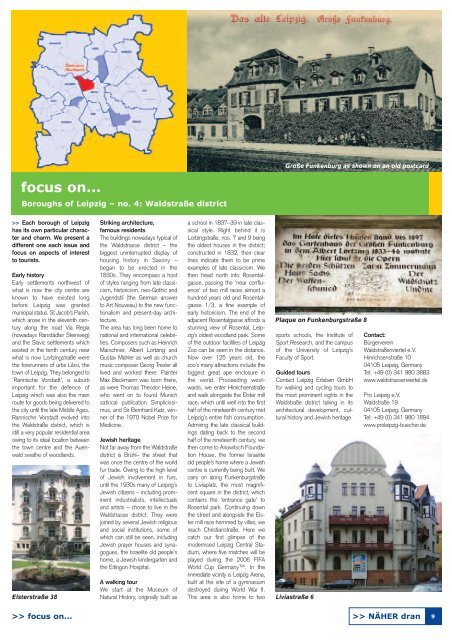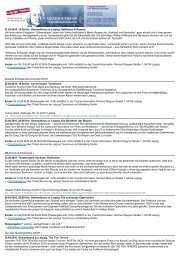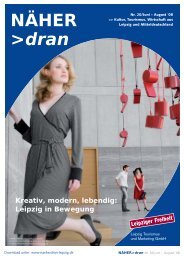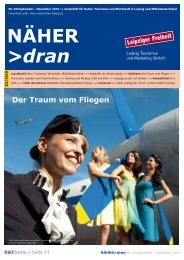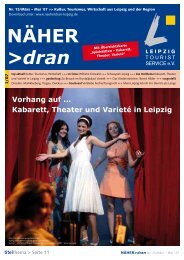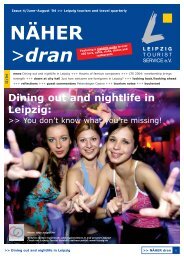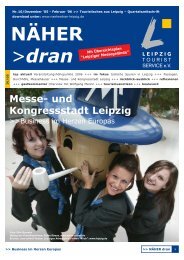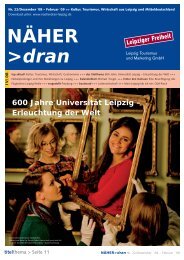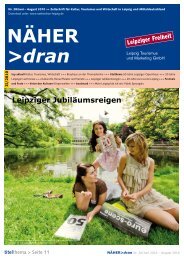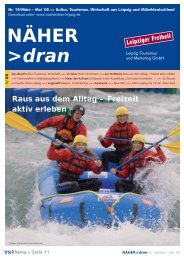focus on... - Leipzig Tourismus und Marketing GmbH
focus on... - Leipzig Tourismus und Marketing GmbH
focus on... - Leipzig Tourismus und Marketing GmbH
You also want an ePaper? Increase the reach of your titles
YUMPU automatically turns print PDFs into web optimized ePapers that Google loves.
<str<strong>on</strong>g>focus</str<strong>on</strong>g> <strong>on</strong>...<br />
Boroughs of <strong>Leipzig</strong> – no. 4: Waldstraße district<br />
>> Each borough of <strong>Leipzig</strong><br />
has its own particular character<br />
and charm. We present a<br />
different <strong>on</strong>e each issue and<br />
<str<strong>on</strong>g>focus</str<strong>on</strong>g> <strong>on</strong> aspects of interest<br />
to tourists.<br />
Early history<br />
Early settlements northwest of<br />
what is now the city centre are<br />
known to have existed l<strong>on</strong>g<br />
before <strong>Leipzig</strong> was granted<br />
municipal status. St Jacob’s Parish,<br />
which arose in the eleventh century<br />
al<strong>on</strong>g the road Via Regia<br />
(nowadays Ranstädter Steinweg)<br />
and the Slavic settlements which<br />
existed in the tenth century near<br />
what is now Lortzingstraße were<br />
the forerunners of urbs Libsi, the<br />
town of <strong>Leipzig</strong>. They bel<strong>on</strong>ged to<br />
‘Rannische Vorstadt’, a suburb<br />
important for the defence of<br />
<strong>Leipzig</strong> which was also the main<br />
route for goods being delivered to<br />
the city until the late Middle Ages.<br />
Rannische Vorstadt evolved into<br />
the Waldstraße district, which is<br />
still a very popular residential area<br />
owing to its ideal locati<strong>on</strong> between<br />
the town centre and the Auenwald<br />
swathe of woodlands.<br />
Elsterstraße 38<br />
>> <str<strong>on</strong>g>focus</str<strong>on</strong>g> <strong>on</strong>...<br />
Striking architecture,<br />
famous residents<br />
The buildings nowadays typical of<br />
the Waldstrasse district – the<br />
biggest uninterrupted display of<br />
housing history in Sax<strong>on</strong>y –<br />
began to be erected in the<br />
1830s. They encompass a host<br />
of styles ranging from late classicism,<br />
historicism, neo-Gothic and<br />
Jugendstil (the German answer<br />
to Art Nouveau) to the new functi<strong>on</strong>alism<br />
and present-day architecture.<br />
The area has l<strong>on</strong>g been home to<br />
nati<strong>on</strong>al and internati<strong>on</strong>al celebrities.<br />
Composers such as Heinrich<br />
Marschner, Albert Lortzing and<br />
Gustav Mahler as well as church<br />
music composer Georg Trexler all<br />
lived and worked there. Painter<br />
Max Beckmann was born there,<br />
as were Thomas Theodor Heine,<br />
who went <strong>on</strong> to fo<strong>und</strong> Munich<br />
satirical publicati<strong>on</strong> Simplicissimus,<br />
and Sir Bernhard Katz, winner<br />
of the 1970 Nobel Prize for<br />
Medicine.<br />
Jewish heritage<br />
Not far away from the Waldstraße<br />
district is Brühl– the street that<br />
was <strong>on</strong>ce the centre of the world<br />
fur trade. Owing to the high level<br />
of Jewish involvement in furs,<br />
until the 1930s many of <strong>Leipzig</strong>’s<br />
Jewish citizens – including prominent<br />
industrialists, intellectuals<br />
and artists – chose to live in the<br />
Waldstrasse district. They were<br />
joined by several Jewish religious<br />
and social instituti<strong>on</strong>s, some of<br />
which can still be seen, including<br />
Jewish prayer houses and synagogues,<br />
the Israelite old people’s<br />
home, a Jewish kindergarten and<br />
the Eiting<strong>on</strong> Hospital.<br />
A walking tour<br />
We start at the Museum of<br />
a school in 1837–39 in late classical<br />
style. Right behind it is<br />
Lortzingstraße, nos. 7 and 9 being<br />
the oldest houses in the district;<br />
c<strong>on</strong>structed in 1832, their clear<br />
lines indicate them to be prime<br />
examples of late classicism. We<br />
then head north into Rosentalgasse,<br />
passing the ‘near c<strong>on</strong>fluence’<br />
of two mill races almost a<br />
h<strong>und</strong>red years old and Rosentalgasse<br />
1/3, a fine example of<br />
early historicism. The end of the<br />
adjacent Rosentalgasse affords a<br />
stunning view of Rosental, <strong>Leipzig</strong>’s<br />
oldest woodland park. Some<br />
of the outdoor facilities of <strong>Leipzig</strong><br />
Zoo can be seen in the distance.<br />
Now over 125 years old, the<br />
zoo’s many attracti<strong>on</strong>s include the<br />
biggest great ape enclosure in<br />
the world. Proceeding westwards,<br />
we enter Hinrichsenstraße<br />
and walk al<strong>on</strong>gside the Elster mill<br />
race, which until well into the first<br />
half of the nineteenth century met<br />
<strong>Leipzig</strong>’s entire fish c<strong>on</strong>sumpti<strong>on</strong>.<br />
Admiring the late classical buildings<br />
dating back to the sec<strong>on</strong>d<br />
half of the nineteenth century, we<br />
then come to Ariowitsch Fo<strong>und</strong>ati<strong>on</strong><br />
House, the former Israelite<br />
old people’s home where a Jewish<br />
centre is currently being built. We<br />
carry <strong>on</strong> al<strong>on</strong>g Funkenburgstraße<br />
to Liviaplatz, the most magnificent<br />
square in the district, which<br />
c<strong>on</strong>tains the ‘entrance gate’ to<br />
Rosental park. C<strong>on</strong>tinuing down<br />
the street and al<strong>on</strong>gside the Elster<br />
mill race hemmed by villas, we<br />
reach Christianstraße. Here we<br />
catch our first glimpse of the<br />
modernised <strong>Leipzig</strong> Central Stadium,<br />
where five matches will be<br />
played during the 2006 FIFA<br />
World Cup Germany. In the<br />
immediate vicinity is <strong>Leipzig</strong> Arena,<br />
built at the site of a gymnasium<br />
destroyed during World War II.<br />
This area is also home to two<br />
Natural History, originally built as Liviastraße 6<br />
Große Funkenburg as shown <strong>on</strong> an old postcard<br />
Plaque <strong>on</strong> Funkenburgstraße 8<br />
sports schools, the Institute of<br />
Sport Research, and the campus<br />
of the University of <strong>Leipzig</strong>’s<br />
Faculty of Sport.<br />
Guided tours<br />
C<strong>on</strong>tact <strong>Leipzig</strong> Erleben <strong>GmbH</strong><br />
for walking and cycling tours to<br />
the most prominent sights in the<br />
Waldstraße district taking in its<br />
architectural development, cultural<br />
history and Jewish heritage.<br />
C<strong>on</strong>tact:<br />
Bürgerverein<br />
Waldstraßenviertel e.V.<br />
Hinrichsenstraße 10<br />
04105 <strong>Leipzig</strong>, Germany<br />
Tel: +49 (0) 341 980 3883<br />
www.waldstrassenviertel.de<br />
Pro <strong>Leipzig</strong> e.V.<br />
Waldstraße 19<br />
04105 <strong>Leipzig</strong>, Germany<br />
Tel: +49 (0) 341 980 1894<br />
www.proleipzig-buecher.de<br />
>> NÄHER dran<br />
9


